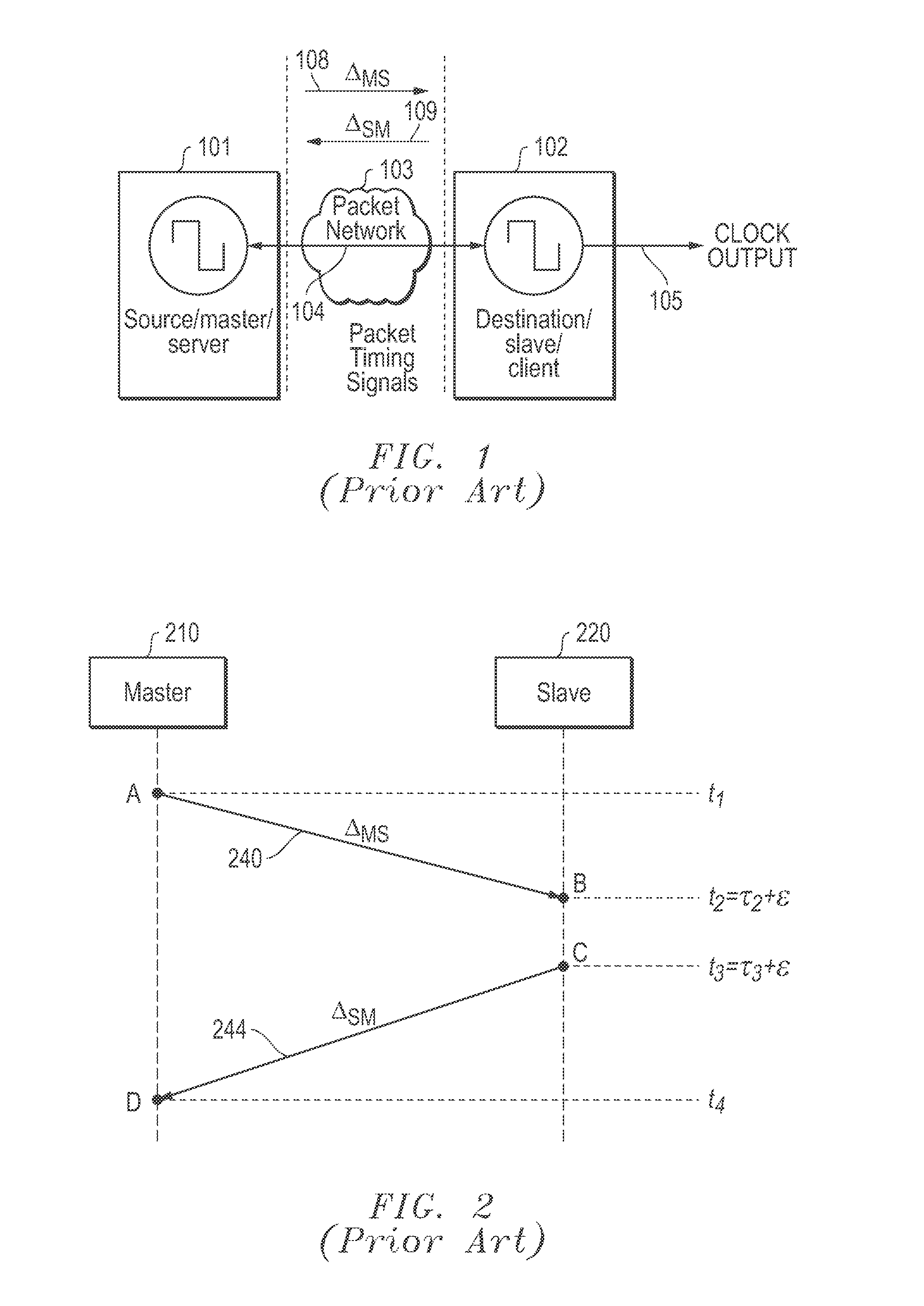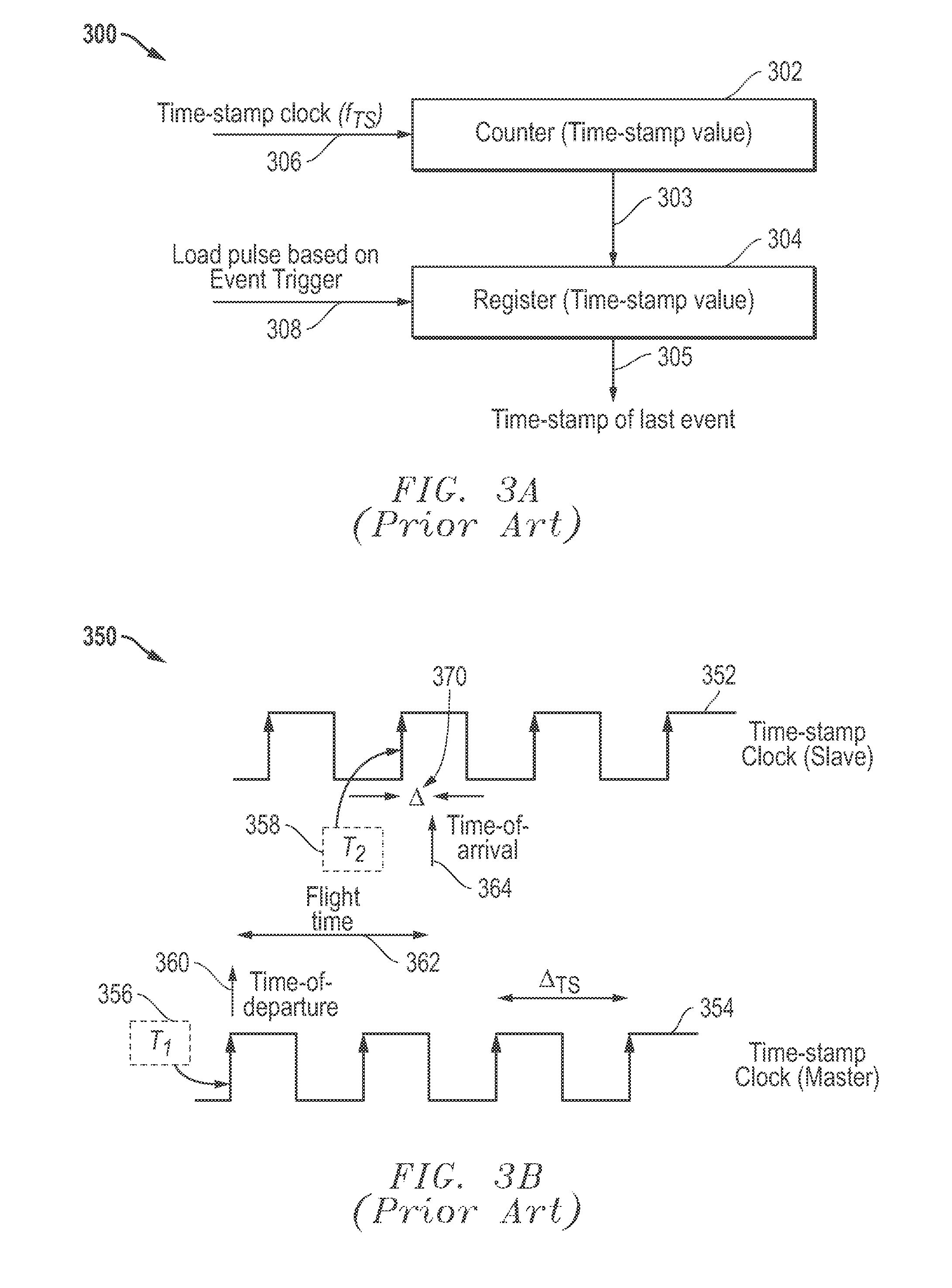Systems and methods utilizing randomized clock rates to reduce systematic time-stamp granularity errors in network packet communications
a time-stamp granularity and network packet technology, applied in the field of time-stamp granularity errors in network packet communications, can solve the problems of not being addressed, randomly distributed, introducing significant, and affecting the accuracy and precision of slaves,
- Summary
- Abstract
- Description
- Claims
- Application Information
AI Technical Summary
Benefits of technology
Problems solved by technology
Method used
Image
Examples
embodiment 400
[0049]FIG. 4 is a block diagram of an embodiment 400 for a system utilizing randomized time-of-arrival time-stamp clocks, as described herein, that have clock rates for slave time-stamp clocks that are intentionally different from the clock rates for the master time-stamp clocks. For convenience, the master-to-slave direction is considered with respect to FIG. 4, as the reverse from slave-to-master would be similar. As depicted, the Master time-stamp clock 404 has a master clock rate (fM), and the Slave time-stamp clock 414 has a slave clock rate (fS) that is intentionally different from the Master time-stamp clock rate (fS≠fM). This randomizing of clock rates allows for systematic granularity errors to be reduced or eliminated with downstream filtering techniques, such as low-pass filters in clock recovery loops.
[0050]It is again noted that the master device is the sender device sending or transmitting the initial timing packets, and the slave device is the receive device receiving...
embodiment 500
[0061]FIG. 5 is a block diagram of an embodiment 500 implementing a solution where the ratio of the time-stamp clock frequencies (fS / fM) is a rational number represented by R / T. As depicted, slave time-stamp clock 414 has a slave clock frequency (fS) that is related to the master clock frequency (fM) of the master time-stamp clock 404 by a non-integer number. As such, the ratio of the time-stamp clock frequencies (fS / fM) is a rational number. This relation can be represented by the following equation:
(fS / fM)=(TM / TS)=R / T (Eq. 8)
where R / T is preferably a rational number (i.e., R and T are integers), and where T is preferably a large number.
[0062]As one implementation, the slave time-stamp clock rate (fS) can be selected to be slightly offset from the master time-stamp clock rate (fM). For example, with respect to a master time-stamp clock rate of 125 MHz, as describe above for Gigabit / sec Ethernet communications, a slave time-stamp clock rate of 124 MHz would be an advantageous rate ...
embodiment 600
[0066]FIG. 6 is a block diagram of an embodiment 600 for a implementation where two time-stamps are used to detect a systematic granularity error. As depicted, a master time-stamp clock (fM) 404 is provided to a master time-stamp generator 406 to produce a master time-stamp (TSM) 602. As described herein, a slave time-stamp (TSS-S) 614 is generated by slave time-stamp generator 610 using a randomized slave time-stamp clock 608 operating at a rate (fS) that is different from the rate (fM) of the master time-stamp clock 404. In addition, a slave time-stamp (TSS-M) is also generated by the slave time-stamp generator 610 using a standard slave time-stamp clock 606 operating at a rate (fM) implying that is the same rate, and possibly syntonized, with the master time-stamp clock 402.
[0067]By taking time-stamps using both a standard syntonized slave time-stamp clock 606 and a randomized slave time-stamp clock 608 at the same time, a determination can be made of the existence and magnitude ...
PUM
 Login to View More
Login to View More Abstract
Description
Claims
Application Information
 Login to View More
Login to View More - R&D
- Intellectual Property
- Life Sciences
- Materials
- Tech Scout
- Unparalleled Data Quality
- Higher Quality Content
- 60% Fewer Hallucinations
Browse by: Latest US Patents, China's latest patents, Technical Efficacy Thesaurus, Application Domain, Technology Topic, Popular Technical Reports.
© 2025 PatSnap. All rights reserved.Legal|Privacy policy|Modern Slavery Act Transparency Statement|Sitemap|About US| Contact US: help@patsnap.com



